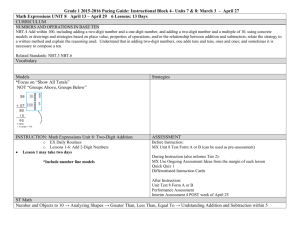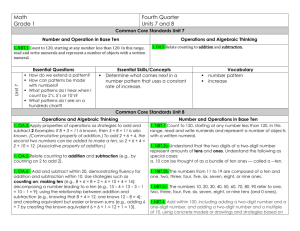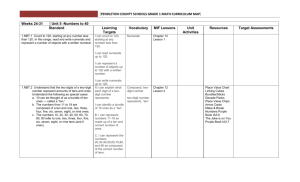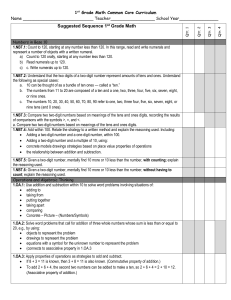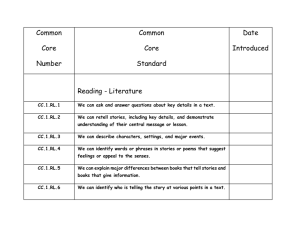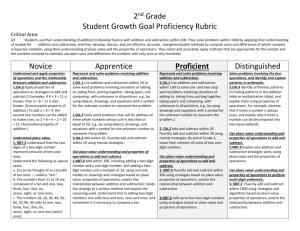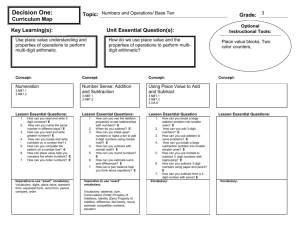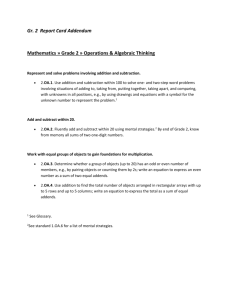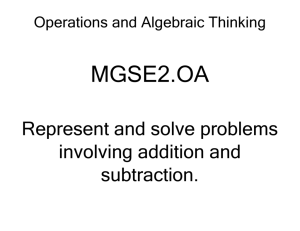Math Instructional Calendar Saxon
advertisement
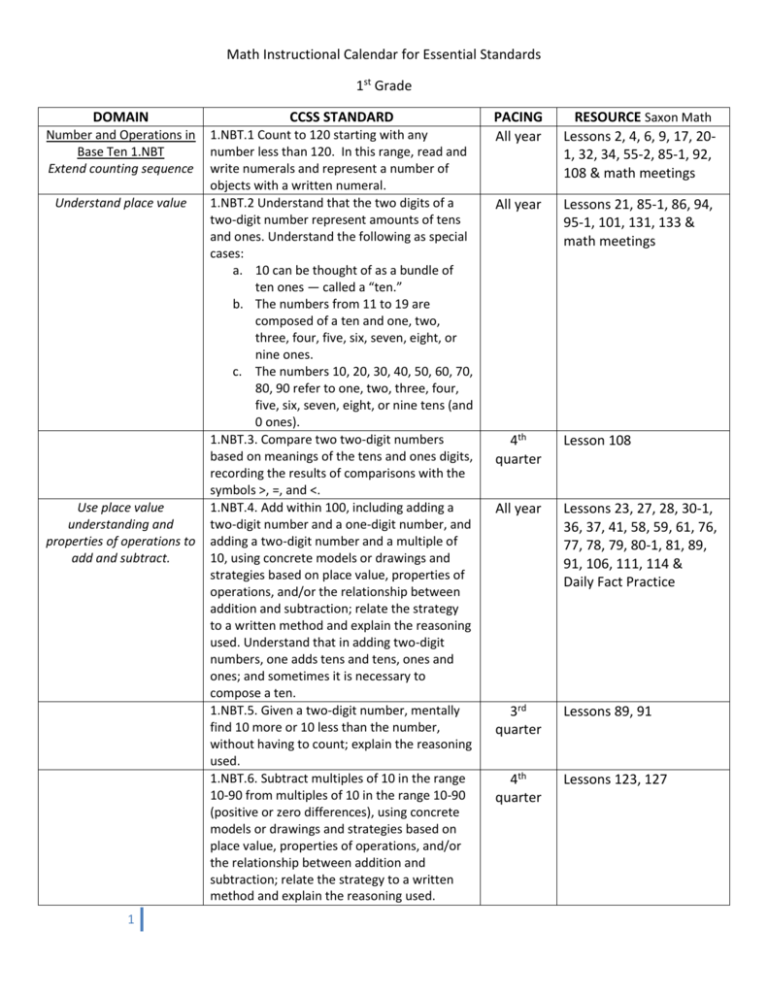
Math Instructional Calendar for Essential Standards 1st Grade DOMAIN CCSS STANDARD Number and Operations in Base Ten 1.NBT Extend counting sequence 1.NBT.1 Count to 120 starting with any number less than 120. In this range, read and write numerals and represent a number of objects with a written numeral. 1.NBT.2 Understand that the two digits of a two-digit number represent amounts of tens and ones. Understand the following as special cases: a. 10 can be thought of as a bundle of ten ones — called a “ten.” b. The numbers from 11 to 19 are composed of a ten and one, two, three, four, five, six, seven, eight, or nine ones. c. The numbers 10, 20, 30, 40, 50, 60, 70, 80, 90 refer to one, two, three, four, five, six, seven, eight, or nine tens (and 0 ones). 1.NBT.3. Compare two two-digit numbers based on meanings of the tens and ones digits, recording the results of comparisons with the symbols >, =, and <. 1.NBT.4. Add within 100, including adding a two-digit number and a one-digit number, and adding a two-digit number and a multiple of 10, using concrete models or drawings and strategies based on place value, properties of operations, and/or the relationship between addition and subtraction; relate the strategy to a written method and explain the reasoning used. Understand that in adding two-digit numbers, one adds tens and tens, ones and ones; and sometimes it is necessary to compose a ten. 1.NBT.5. Given a two-digit number, mentally find 10 more or 10 less than the number, without having to count; explain the reasoning used. 1.NBT.6. Subtract multiples of 10 in the range 10-90 from multiples of 10 in the range 10-90 (positive or zero differences), using concrete models or drawings and strategies based on place value, properties of operations, and/or the relationship between addition and subtraction; relate the strategy to a written method and explain the reasoning used. Understand place value Use place value understanding and properties of operations to add and subtract. 1 PACING All year RESOURCE Saxon Math Lessons 2, 4, 6, 9, 17, 201, 32, 34, 55-2, 85-1, 92, 108 & math meetings All year Lessons 21, 85-1, 86, 94, 95-1, 101, 131, 133 & math meetings 4th quarter Lesson 108 All year Lessons 23, 27, 28, 30-1, 36, 37, 41, 58, 59, 61, 76, 77, 78, 79, 80-1, 81, 89, 91, 106, 111, 114 & Daily Fact Practice 3rd quarter Lessons 89, 91 4th quarter Lessons 123, 127 DOMAIN Operations and Algebraic Thinking 1.OA Represent and solve problems involving addition and subtraction. Add and subtract within 20. Understand and apply properties of operations and the relationship between addition and subtraction. CCSS STANDARD 1.OA.1. Use addition and subtraction within 20 to solve word problems involving situations of adding to, taking from, putting together, taking apart, and comparing, with unknowns in all positions, e.g., by using objects, drawings, and equations with a symbol for the unknown number to represent the problem. 1.OA.2. Solve word problems that call for addition of three whole numbers whose sum is less than or equal to 20, e.g., by using objects, drawings, and equations with a symbol for the unknown number to represent the problem. 1.OA.6. Add and subtract within 20, demonstrating fluency for addition and subtraction within 10. Use strategies such as counting on; making ten (e.g., 8 + 6 = 8 + 2 + 4 = 10 + 4 = 14); decomposing a number leading to a ten (e.g., 13 – 4 = 13 – 3 – 1 = 10 – 1 = 9); using the relationship between addition and subtraction (e.g., knowing that 8 + 4 = 12, one knows 12 – 8= 4); and creating equivalent but easier or known sums (e.g., adding 6 +7 by creating the known equivalent 6 + 6 + 1 = 12 + 1 = 13). 1.OA.3 Apply properties of operations and strategies to add and subtract. Examples: if 8 + 3 = 11 is known, then 3 + 8 = 11 is also known. (Commutative property of addition) To add 2 + 6 + 4, the second two numbers can be added to make a ten, so 2 + 6 + 4 = 2 + 10 = 12. (Associative property of addition) Add and subtract within 20. 1.OA.5 Relate counting to addition and subtraction (e.g., by counting on 2 to add 2). Work with addition and subtraction equations. 1.OA.7 Understand the meaning of the equal sign, and determine if equations involving addition and subtraction are true or false. For example, which of the following equations are true and which are false? 6 = 6, 7 = 8 – 1, 5 + 2 = 2 + 5, 4 + 1 = 5 + 2. 1.MD.3 Tell and write time in hours and halfhours using analog and digital clocks. Measurement and Data 1.MD Tell and write time. 2 PACING All year RESOURCE Saxon Math Lessons 10-2, 12, 15-1, 20-2, 21, 25-1, 30-2, 33, 40-2, 50-2, 60-2, 70-2, 802, 90-2, 100-2, 110-2, 120-2, 130-2 & Daily Written Practice 4th quarter Lesson 114 Not targeted in Saxon. Teacher must supplement. All year Lessons 23, 27, 28, 30-1, 36, 37, 41, 44, 45-1, 49, 58, 59, 61, 68, 69, 76, 77, 78, 79, 80-1, 81, 89, 91, 101, 102, 106, 111, 114, 123, 125-1, 129, 132, 134, 135A & Daily Fact Practice All year Lessons 23, 27, 28, 30-1, 36, 37, 41, 58, 59, 61, 76, 77, 78, 79, 80-1, 81, 89, 91, 106, 111, 114 All year Lessons 36, 37, 40-1, 44, 45-1, 58, 59, 61, 68, 69, 89, 91, 123 Lesson 21 Not targeted in Saxon. Teacher must supplement. 2nd & 3rd quarters Lessons 48, 57, 87 DOMAIN CCSS STANDARD Represent and interpret data. 1.MD.4 Organize, describe, represent, and interpret data with up to three categories; ask and answer questions about the total number of data points, how many in category, and how many more or less, fewer or greater, or same as and equal to, are in one category than in another. Manipulate the data using graphing. 1.G.3 Partition circles and rectangles into two and four equal shares, describe the shares using the words halves, fourths, and quarters, and use the phrases half of, fourth of, and quarter of. Describe the whole as two of, or four of the shares. Understand for these examples that decomposing into more equal shares creates smaller shares. Geometry 1.G Reason with shapes and their attributes. 3 PACING All year RESOURCE Saxon Math Lessons 5, 7, 10-1, 19, 38, 40-1, 65-1, 82, 118, 1302, & Math meeting All year Lessons 18, 54, 55-1, 67, 88, 107, 122
